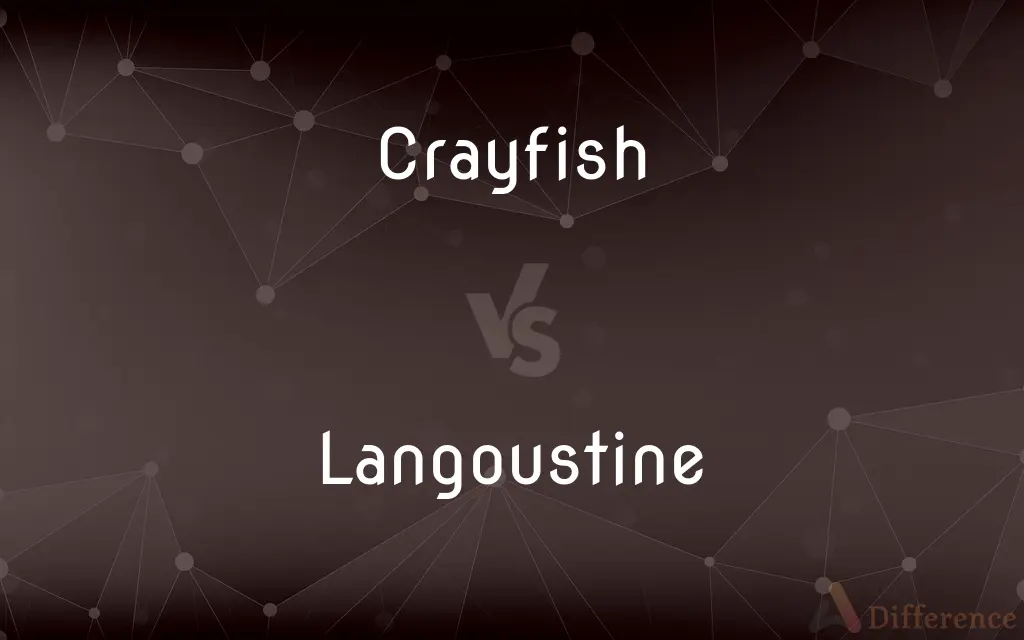Crayfish vs. Langoustine — What's the Difference?
By Tayyaba Rehman & Maham Liaqat — Updated on April 1, 2024
Crayfish are freshwater crustaceans, resembling small lobsters, found in various global regions. Langoustines, marine relatives, are prized for their delicate, sweet meat.

Difference Between Crayfish and Langoustine
Table of Contents
ADVERTISEMENT
Key Differences
While both crayfish and langoustines are part of the crustacean family, they differ significantly in habitat. Crayfish adapt well to a variety of freshwater conditions and can be found in many parts of the world, contributing to their wide culinary use. Langoustines, however, are more selective, thriving in the cold, deep marine waters, which limits their availability to certain geographical areas.
Culinary practices also distinguish between the two. Crayfish are often associated with casual, communal eating experiences, such as outdoor boils, where they are cooked in large pots with vegetables and spices. Langoustines, due to their higher cost and esteemed flavor, are typically prepared in more formal culinary settings, making them a gourmet choice for fine dining.
The conservation and sustainability concerns surrounding crayfish and langoustines vary. Some crayfish species have become invasive in non-native environments, impacting local ecosystems. In contrast, langoustine fisheries are subject to regulation to prevent overfishing, reflecting the high demand and ecological sensitivity associated with these crustaceans.
Comparison Chart
Habitat
Freshwater (rivers, lakes)
Marine (cold, deep waters of the Atlantic)
Body Shape
Robust, wide body with large pincers
Slender, elongated body with small pincers
ADVERTISEMENT
Culinary Use
Casual dishes (boils, stews)
Fine dining (grilled, boiled)
Taste/Texture
Firmer meat, stronger flavor
Delicate, sweet meat
Conservation Status
Some species invasive, others stable
Regulated to prevent overfishing
Compare with Definitions
Crayfish
Most species are solitary except during the mating season.
Crayfish can be aggressive towards each other outside of breeding times.
Langoustine
Subject to strict fishing quotas to prevent overfishing due to their high demand.
Regulations ensure langoustine populations remain sustainable, preserving this valuable seafood resource.
Crayfish
They inhabit a wide range of freshwater environments from slow-moving rivers to lakes.
Crayfish are often found hiding under rocks in streams.
Langoustine
Langoustines are a type of small, marine lobster found in cold, northern waters, esteemed for their sweet meat.
Langoustines are a highlight of Scottish seafood, often featured in Michelin-starred restaurants.
Crayfish
While some are stable, others are invasive and pose ecological challenges.
The red swamp crayfish has become invasive in many parts of the world, disrupting local ecosystems.
Langoustine
Preferring the cold, deep waters of the Atlantic, they are often caught in trawls.
Langoustine fishing is a major industry in Scotland, where the cold North Sea provides an ideal habitat.
Crayfish
Crayfish are freshwater crustaceans with a strong resemblance to lobsters, known for their meaty pincers.
In the spring, crayfish become more active, making it the perfect time for crayfishing.
Langoustine
They feed on small fish and sea creatures found on the ocean floor.
Langoustines maintain a diet rich in high-quality proteins from the sea floor's diverse marine life.
Crayfish
(to backpedal, desert, or withdraw)
Langoustine
Langoustines are more solitary, living in burrows on the sea floor.
Each langoustine creates its own burrow, which it rarely leaves except to feed.
Crayfish
Crayfish are freshwater crustaceans resembling small lobsters (to which they are related). In some parts of the United States, they are also known as crawfish, craydids, crawdaddies, crawdads, freshwater lobsters, mountain lobsters, rock lobsters, mudbugs, or yabbies.
Langoustine
A small edible lobster (Nephrops norvegicus) of the eastern Atlantic Ocean and the Mediterranean Sea, having slender claws. Also called Norway lobster, scampi.
Crayfish
Any of various freshwater crustaceans of the families Astacidae and Cambaridae of the Northern Hemisphere and the family Parastacidae of the Southern Hemisphere, resembling a lobster but considerably smaller. Also called mudbug; also called regionally crawdad.
Langoustine
A small edible European orange-pink lobster, Nephrops norvegicus
Crayfish
See spiny lobster.
Langoustine
Caught in European waters; slenderer than American lobster
Crayfish
Any of numerous freshwater decapod crustaceans in superfamily Astacoidea or Parastacoidea, resembling the related lobster but usually much smaller.
Crayfish
A freshwater crustacean (family Cambaridae), sometimes used as an inexpensive seafood or as fish bait.
Crayfish
A rock lobster (family Palinuridae).
Crayfish
(AU) A freshwater crayfish (family Parastacidae), such as the gilgie, marron, or yabby.
Crayfish
(Singapore) The species Thenus orientalis of the slipper lobster family (Scyllaridae).
Crayfish
To catch crayfish
Crayfish
See Crawfish.
Crayfish
Warm-water lobsters without claws; those from Australia and South Africa usually marketed as frozen tails; caught also in Florida and California
Crayfish
Tiny lobster-like crustaceans usually boiled briefly
Crayfish
Small freshwater decapod crustacean that resembles a lobster
Crayfish
Large edible marine crustacean having a spiny carapace but lacking the large pincers of true lobsters
Common Curiosities
How do crayfish and langoustines contribute to their ecosystems?
Crayfish are important for aquatic ecosystems as omnivores, while langoustines affect marine ecosystems through their burrowing and feeding habits.
Can you eat both crayfish and langoustines?
Yes, both are edible and prized for their distinct flavors in various cuisines.
Are crayfish considered invasive?
Some crayfish species are invasive in non-native waters, affecting local ecosystems.
Can crayfish and langoustines be farmed?
Yes, both can be farmed, but langoustines are more commonly harvested from the wild due to their habitat requirements.
What are the environmental impacts of harvesting crayfish and langoustines?
Crayfish harvesting can spread invasive species, while langoustine trawling can impact seabed habitats.
What is the main habitat difference between crayfish and langoustines?
Crayfish are found in freshwater, while langoustines live in marine environments.
What is the culinary preference for using crayfish over langoustines, or vice versa?
Crayfish are often used in casual, communal dishes, while langoustines are preferred for fine dining due to their delicate taste.
How do crayfish and langoustines differ in appearance?
Crayfish have a robust body and large pincers, whereas langoustines have a slender body and small pincers.
What are the conservation concerns for langoustines?
Overfishing is a concern, hence the implementation of strict fishing quotas.
Why are langoustines considered a delicacy?
They are valued for their sweet, tender meat and are often used in high-end culinary settings.
How does the taste of crayfish compare to that of langoustines?
Crayfish meat is firmer and has a stronger flavor, while langoustine meat is more delicate and sweet.
Share Your Discovery

Previous Comparison
Grated vs. Graded
Next Comparison
Tear vs. RentAuthor Spotlight
Written by
Tayyaba RehmanTayyaba Rehman is a distinguished writer, currently serving as a primary contributor to askdifference.com. As a researcher in semantics and etymology, Tayyaba's passion for the complexity of languages and their distinctions has found a perfect home on the platform. Tayyaba delves into the intricacies of language, distinguishing between commonly confused words and phrases, thereby providing clarity for readers worldwide.
Co-written by
Maham Liaqat














































